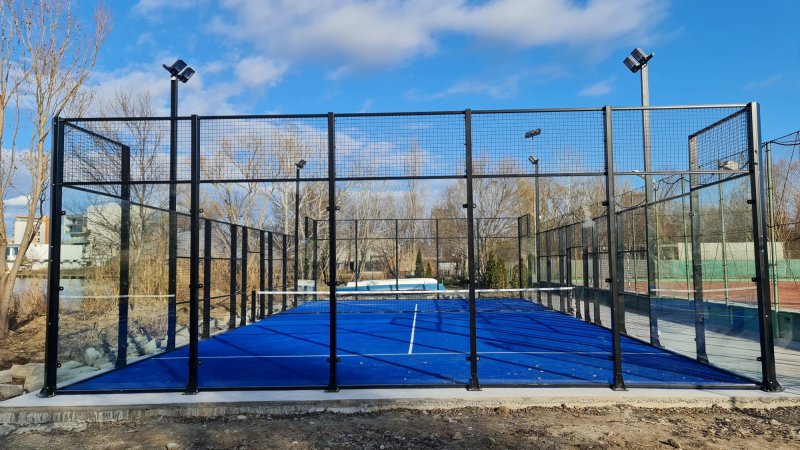Padel, a rapidly expanding sport worldwide, combines elements of tennis and squash, requiring a specially designed court that differs notably from those of its sporting cousins. Success on the court begins with its construction, and pros who desire years of enjoyment from their padel games must adhere to specific guidelines. The selection of a suitable location is paramount, with the ideal siting on a flat, level area that offers good drainage and is shielded from excessive wind, which can impact play.
When it comes to the surface of the court, longevity and safety should be front of mind. Builders commonly employ concrete or asphalt for their durability, topped with a non-slip finish to prevent accidents. Courts must comply with standard measurements, 10 meters in width by 20 meters in length, bordered by walls measuring 3 meters in height, often constructed of glass to afford spectators unobstructed views of the game.
Finally, the quality of fixtures such as netting and lighting fixtures significantly influence the playability of a padel court. Nets must be appropriately tensioned and fabricated from materials that can withstand both the elements and the rigors of the sport. Lighting requires careful consideration to ensure that visibility is maintained for nighttime or low-light play. Additional amenities such as spectator seating, equipment storage, and player conveniences like showers and changing facilities can substantially enhance the padel experience. Regular maintenance of these elements ensures that the court remains in top condition for all who use it.
Location and Site Preparation
When constructing a padel court, the initial step is to find a suitable location. The area must be flat and level to ensure optimal playability. Moreover, a well-prepared site can avert future maintenance issues.
Choosing the Right Site
- Level Ground: The ground should be flat and level without any inclines or declines to ensure consistent ball bounce and game quality.
- Drainage: Implementing good drainage is crucial to prevent water accumulation that can damage the court surface.
- Wind Conditions: Opt for a sheltered area to reduce wind interference which could affect play.
- Accessibility: Ensure the site is accessible for players and emergency services if needed.
Court Surface and Materials
Choosing the appropriate court surface and materials is crucial for achieving a safe and optimal playing experience. The longevity and performance of a padel court heavily rely on the quality and characteristics of the materials used.
Surface Selection
The surface of a padel court plays a pivotal role in the game, as it affects the ball’s behaviour and the players’ comfort and safety. Concrete and asphalt are the preferred options due to their durability and the ability to maintain a non-slip surface. Concrete provides a firmer playing surface that’s durable and requires less maintenance. Asphalt offers a slightly softer surface which can be easier on players’ joints.
Material Considerations
When selecting materials for the court surface, specific characteristics merit consideration:
- Durability: The material must withstand frequent play and variable weather conditions.
- Non-Slip Surface: Safety is paramount; hence a non-slip texture is essential to prevent falls and injuries.
- Maintenance Requiremens: It should be easy to clean and require minimal routine maintenance to retain its playing qualities.
Materials like concrete and asphalt meet these criteria effectively. Concrete is known for its longevity, whereas asphalt offers a balance between durability and playing comfort. It’s important that the selected material promotes a consistent ball bounce and withstands the test of time.
Court Dimensions and Layout
The construction of a padel court requires precise measurements and consideration of the materials used for walls and fencing. Thorough understanding and meticulous adherence to these specifications are pivotal for a standard court design that meets official regulations.
Standard Measurements
A standard padel court is rectangular, with exact dimensions of 20 meters in length and 10 meters in width, ensuring a consistent playing field worldwide. The play area is clearly defined, and the space must comply with these measurements to accommodate the dynamic nature of the game and provide sufficient room for player movement.
Walls and Fencing
On a standard court, the walls play an essential role in the game of padel. The back walls are typically 3 meters high and constructed of glass to facilitate visibility for spectators while maintaining the ball within the court. Side walls first extend with solid materials to a height of 2 meters followed by a metallic fencing in the upper part to maintain the required court height and allow air and light to permeate without disrupting play. The materials used must ensure durability and safety for all players.
Netting and Posts
In padel, the netting and posts are integral to the court, impacting both play and safety. Proper tension and durability of materials are paramount in their selection and maintenance.
Netting Characteristics
The net in padel must be tensioned evenly to avoid any sagging that can affect gameplay. Net height is a critical aspect, with the official requirement set at 88 centimeters in the center and 92 centimeters at the posts. The material used for the net should be durable to withstand weather conditions and continuous use. Typically, a polyethylene mesh is utilized for its resilience and longevity.
- Material: Polyethylene mesh or equivalent
- Height: 88 cm (center), 92 cm (posts)
- Durability: Weather-resistant, long-lasting
Post Placement and Stability
Posts should be positioned precisely at the sides of the court, embedding them securely to ensure stability. They should be constructed from materials like galvanized steel to resist rust and corrosion. The posts must maintain rigidity to keep the net at the correct height and tension throughout.
- Material: Galvanized steel or equivalent, corrosion-resistant
- Placement: Exact alignment with the court’s sides
- Stability: Embedded and secure, maintaining net tension
Lighting Setup
Proper lighting is crucial for padel courts to ensure the game is playable during the night or in low-light conditions. The lighting system needs to provide even illumination that mimics natural daylight conditions.
Illumination for Playability
For optimal playability, LED lights are the preferred choice due to their long lifespan and energy efficiency. The ideal lux level—a measure of light intensity—on the court should range from 300 to 500 lux, adequate for both amateur and professional play.
Placement: Lights should be installed at strategic positions to avoid glare and shadows on the playing area. Poles, typically around 6 meters tall, are placed at the corners of the court.
Distribution: The lights must be evenly distributed to cover the court uniformly without creating dark spots.
Controls: Installation of adaptable lighting controls allows for adjusting the brightness levels based on the time of day and current weather conditions.
To sum up:
- Type: LED lights
- Intensity: 300-500 lux
- Height of Poles: ~6 meters
- Light Placement: Corners of the court
- Even Distribution: No dark spots or glare
- Control System: For brightness adjustment




